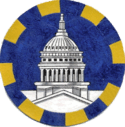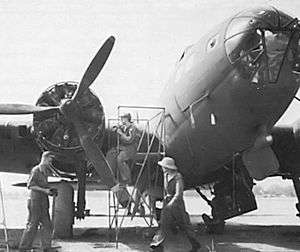14th Bombardment Squadron
| 14th Bombardment Squadron | |
|---|---|
|
14th Bombardment Squadron B-17E, Clark Field, Philippines before the 8 December 1941 attack | |
| Active |
1917–1946 (Not equipped or manned, May 1942 – April 2, 1946) |
| Country | United States |
| Branch | United States Army Air Forces |
| Role | Bombardment |
| Part of | Far East Air Force |
| Engagements |
World War II Battle of the Philippines |
| Insignia | |
| 14th Bombardment Squadron emblem |
 |
The 14th Bombardment Squadron is an inactive United States Air Force unit. The 14th Bomb Squadron fought in the Battle of the Philippines (1941–42), much of its aircraft being destroyed in combat against the Japanese. The survivors of the ground echelon fought as infantry during Battle of Bataan and after their surrender, were subjected to the Bataan Death March, although some did escape to Australia. The remainder of the air echelon fought in the Dutch East Indies campaign (1942) before being reassigned to other units. The squadron was never remanned or equipped. It was carried as an active unit until April 2, 1946.
History
World War I
Operated as a flying training unit, 1917–1918.
Inter-war years
Operated from Bolling Field, DC, 1928–1935. A C-2A transport of the squadron participated as the receiving aircraft ("Question Mark") in a week-long endurance flight testing the practicability of aerial refueling.
World War II
The 19th Bombardment Group had been selected for transfer to the Philippines; however, the need for B-17 bombers there was so urgent that a provisional group already in Hawaii was dispatched to Manila by way of Australia in September.[1] Under the command of Maj Emmett O'Donnell, Jr., nine B-17s of the 14th Bombardment Squadron (Provisional),the nine crews made up of the cream of the 5th and 11th Bomb Groups, pioneered an air ferry route from Hawaii to the Philippines, leaving on September 5, 1941, and arriving on September 12, 1941, at Clark Field, Philippines. This was the first flight of land-based bombers across the central Pacific. A portion of the flight involved traversing uncharted waters from Wake Island to Port Moresby and Darwin and thence to Fort Stotsenburg. They maintained radio silence over the Japanese mandate islands. Successful completion of this historic flight proved that the Philippines could be reinforced by air. For extraordinary achievement in this flight, the airmen of this squadron were awarded the Distinguished Flying Cross. The squadron became part of the Philippine Department Air Force, which subsequently became the Far East Air Force on November 16, 1941, and was attached to the 19th Bombardment Group (Heavy).
On December 8, 1941, the Japanese bombed and strafed Clark Field at 12:00 pm, catching many B-17’s and P-40’s on the ground, which were destroyed. Sixteen B-17s of the 14th Bombardment Squadron aircraft were based at Del Monte Field and San Marcelino Field and were spared being destroyed. Captain Colin P Kelly Jr, of the 14th Bombardment Squadron attacked the Japanese Navy heavy cruiser Ashigara, thought to be a battleship. Captain Kelly was killed when his B-17 was shot down by Japanese fighters as he was returning to Clark Field, and was posthumously awarded the Distinguished Service Cross (DSC).
The air echelon of the 14th Bombardment Squadron was evacuated to Batchelor Field, Australia on December 24, 1941, while the ground echelon stayed to fight at Clark Field, as infantry in the Philippines as part of the Battle of the Philippines under the command of 5th Interceptor Command. Orders were soon received from HQ Far East Air Force to move to Java, and the air echelon relocated from Batchelor Field to Singosari Field, Java on December 30, 1941.
The 19th Bombardment Group flew missions from Singosari Field, attacking enemy aircraft, ground installations, warships and transports during the later stages of the Battle of the Philippines and the Dutch East Indies campaign between January–March 1942. The group earned a total of four United States Presidential Distinguished Unit Citations for actions in the Philippine Islands and Dutch East Indies. The air echelon of 14th Bombardment Squadron ceased operating from Singosari, Java on March 1, 1942, and began moving to Melbourne, Australia. Arriving at Essendon Aerodrome, Melbourne on March 4, 1942, the air echelon of 14th Bombardment Squadron began operating from Essendon, Australia.
On March 14, 1942, the air echelon of 14th Bombardment Squadron was detached from the 19th Bombardment Group and ceased operations, with men and equipment transferred to other units. The 14th Bombardment Squadron continued as an active unit in the United States, but was not manned or equipped, and was inactivated on April 2, 1946.
Lineage
- Organized as 1st Aviation School Squadron on May 9, 1917
- Redesignated: 14th Aero Squadron (I) on August 20, 1917
- Redesignated: Squadron A, Rockwell Field, Calif, on July 23, 1918
- Demobilized on November 23, 1918
- Reconstituted and consolidated (June 8, 1935) with Air Corps Detachment, Bolling Field, DC, which was organized on April 1, 1928
- Redesignated: 14th Bombardment Squadron on March 1, 1935
- Inactivated on September 1, 1936
- Redesignated 14th Bombardment Squadron (Medium) on December 22, 1939
- Activated on February 1, 1940
- Redesignated: 14th Bombardment Squadron (Heavy) on November 20, 1940
- Inactivated on April 2, 1946
- Disbanded on August 19, 1949.
* Another 14th Aero Squadron was activated at Kelly Field, Texas, on 14 June 1917. It was re-designated as the 19th Aero Squadron on 26 June 1917. Today the squadron's lineage and history is held by the USAF 19th Fighter Squadron
Assignments
- Unknown, 1917–1918
- Office of Chief of Air Corps, April 1, 1928
- Third Corps Area, August 28, 1933
- 9th Bombardment Group, March 1, 1935 – September 1, 1936
- 11th Bombardment Group, February 1, 1940
- 7th Bombardment Group, December 2, 1941 – April 2, 1946
- Attached to 19th Bombardment Group, 2-c. December 24, 1941
- Air echelon attached to 19th Bombardment Group, C. December 24, 1941 – c. March 14, 1942
- Ground echelon attached as infantry to the V Interceptor Command, c. December 24, 1941 – May 1942
Stations
- Rockwell Field, California, May 9, 1917 – November 23, 1918
- Bolling Field, Washington, D.C., April 1, 1928 – September 1, 1936
- Hickam Field, Hawaii Territory, February 1, 1940
- Clark Field, Luzon, Philippines Commonwealth, September 16, 1941
- Bugo, Mindanao, Philippines Commonwealth, (Ground echelon) January 1 – May 1942
- Air echelon operated from: Batchelor Airfield, Australia, c. December 24–c. December 30, 1941
- Air echelon operated from: Singosari Airport, Java, Netherlands East Indies, December 30, 1941–c. March 1, 1942
- Air echelon operated from: Essendon Airport (Melbourne), Australia, c. March 4 – c. March 14, 1942
Aircraft
- JN-4, JN-6, and S-4 during period 1917–1918.
- O-1, 1928 – c. 1930,
- Douglas O-2 and P-1 Hawk, 1928 – c. 1931,
- O-38, 1931–1935,
- included, DH-4, A-3, Douglas C-1, C-2, C-4, C-5, C-6, C-9, C-n, Y1C-12, Y1C-17, Y1C-19, Lockheed Y1C-23, C-30 Condor, C-34, O-11, O-13, O-29, O-43, OA-1, PW-9, Boeing P-12, P-26 Peashooter, AT-5, PT-1, BT-2, and apparently YB-9, Martin B-10, C-29 Dolphin, and Thomas-Morse YO-20 during period 1928–1936
- B-18 Bolo, 1940–1941
- B-17 Flying Fortress, 1941
- B-17, and probably B-24 and LB-30, December 7, 1941 – c. March 1, 1942
See also
Notes
![]() This article incorporates public domain material from the Air Force Historical Research Agency website http://www.afhra.af.mil/.
This article incorporates public domain material from the Air Force Historical Research Agency website http://www.afhra.af.mil/.
- ↑ Matloff 1953-59, p. 70.
References
- Matloff, Maurice; Snell, Edwin M. (1953–59). The War Department: Strategic Planning For Coalition Warfare 1941-1942. United States Army In World War II. Washington, DC: Center Of Military History, United States Army. LCCN 53061477.
- Maurer, Maurer, ed. (1982) [1969]. Combat Squadrons of the Air Force, World War II (PDF) (reprint ed.). Washington, DC: Office of Air Force History. ISBN 0-405-12194-6. LCCN 70605402. OCLC 72556.
- 14th Bomb Squadron

.svg.png)